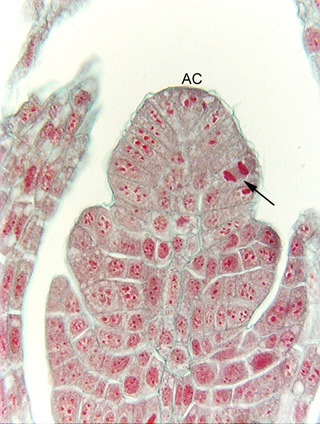Up
Apical meristem
Basal meristem
Basal meristem
Intercalary meristem
Axillary meristem
Axillary meristem
Meristemoid
Procambium
Protoderm, promeristem
Apical cell, fern
Apical cell, Equisetum
Mantle-Core
Tunica-Corpus
CMC zone
Corpus zonation
Cocklebur apex
Large apex, cactus
Large CMC. PRM
Large PZ
Files of cells
Axillary bud, Coleus
Axillary bud, ash
Fern root tip
Fern root, mag
Cattail root tip
Cattail apex, mag
Cattail root cap
Root protoderm
Symplastic growth
Corn root
Corn root, mag
| |
 Fig. 6.3-2.
Longitudinal section of a shoot tip of horsetail (Equisetum arvense, also
called scouring rush). Like ferns, equistems are plants that reproduce with just
spores, not seeds, and similarly, their shoot apical meristems have a prominent
apical cell. The cell itself is not particularly easy to see in this micrograph,
but notice cells (and their nuclei) on either side: all the cells are rather
flat and brick-shaped, and they are oriented parallel to the sides of the apical
cell. In the apex of Nephrolepis (Fig. 6.3-1b), the lateral progeny cells
quickly undergo a transverse division, but here they do not do that, so it is
easier to see that these cells are related to the apical cell. Fig. 6.3-2.
Longitudinal section of a shoot tip of horsetail (Equisetum arvense, also
called scouring rush). Like ferns, equistems are plants that reproduce with just
spores, not seeds, and similarly, their shoot apical meristems have a prominent
apical cell. The cell itself is not particularly easy to see in this micrograph,
but notice cells (and their nuclei) on either side: all the cells are rather
flat and brick-shaped, and they are oriented parallel to the sides of the apical
cell. In the apex of Nephrolepis (Fig. 6.3-1b), the lateral progeny cells
quickly undergo a transverse division, but here they do not do that, so it is
easier to see that these cells are related to the apical cell.
On the right side, the two very dark red masses are the two nuclei
re-forming in the latter stage of nuclear division (arrow; this is anaphase --
the dark mass between the two nuclei is the spindle). Notice that this division
will produce an outer cell and an inner one -- the outer cell will start the
formation of a leaf at this site. All the nuclei here have small dark red
splotches -- those are nucleoli. Look carefully at a set of nucleoli -- you will
see a slightly darker mass of gray material, which is the nucleus itself. The
nuclei have been stained almost the same color as the cytoplasm, which is
unusual; typically nuclei stain red and cytoplasm stains blue/green.
|
 Fig. 6.3-2.
Longitudinal section of a shoot tip of horsetail (Equisetum arvense, also
called scouring rush). Like ferns, equistems are plants that reproduce with just
spores, not seeds, and similarly, their shoot apical meristems have a prominent
apical cell. The cell itself is not particularly easy to see in this micrograph,
but notice cells (and their nuclei) on either side: all the cells are rather
flat and brick-shaped, and they are oriented parallel to the sides of the apical
cell. In the apex of Nephrolepis (Fig. 6.3-1b), the lateral progeny cells
quickly undergo a transverse division, but here they do not do that, so it is
easier to see that these cells are related to the apical cell.
Fig. 6.3-2.
Longitudinal section of a shoot tip of horsetail (Equisetum arvense, also
called scouring rush). Like ferns, equistems are plants that reproduce with just
spores, not seeds, and similarly, their shoot apical meristems have a prominent
apical cell. The cell itself is not particularly easy to see in this micrograph,
but notice cells (and their nuclei) on either side: all the cells are rather
flat and brick-shaped, and they are oriented parallel to the sides of the apical
cell. In the apex of Nephrolepis (Fig. 6.3-1b), the lateral progeny cells
quickly undergo a transverse division, but here they do not do that, so it is
easier to see that these cells are related to the apical cell.